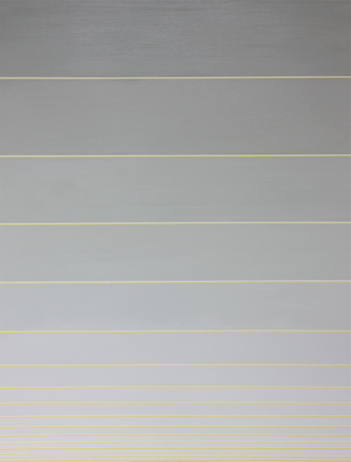Brian Caraway
we are the dreamer of dreams
June 6 - July 24, 2014
Brian Caraway
we are the dreamer of dreams
June 6 - July 24, 2014
Chandra Cerrito Contemporary




Brian Caraway
The Event Horizon, 2014
acrylic on panel
47 x 35.5 inches



MY MATHEMATICAL ROMANCE
I have a crush on mathematics: call it a hobby or a fascination, but for me it is a passionate (if one-sided) affair. My work uses precise measurement and calculated repetition to consider the division of space and the infinite series of sequences that make up the universe -- or at the very least, those small pockets of the universe that sit between my paintings and the viewer.
I borrowed the phrase "Mathematical Romance" from an article about Edward Frenkel, a Russian child prodigy in mathematics who now teaches at U.C. Berkeley. Frenkel fascinates me: I see him as a heroic figure, a giant in his field. We are working at completely different ends of the spectrum – he’s investigating the abstract building blocks of the universe, while I keep my terrestrial explorations confined to one, or nine, paintings at a time. Still, in Frenkel I find a larger-than-life reflection of my own passion for the abstract but perfect language of mathematics.
Increasingly my work is about precise measurement, color, and finish. I set up relationships between color and shape by precisely measuring bands of a given set of colors. A particular painting might be built from six or seven yellows, but set together in such an arrangement that the eye doesn't read them as more than two or three. Like singers' voices blending and harmonizing together, I think of these color relationships as a musical dynamic being explored optically. Music is "the most immaterial form of art" according to Marina Abramovic and my paintings are designed to generate an abstract, immaterial moment once the colors I've deployed arrive at your eyes. The colors ultimately serve the measured composition in much the same way that the abstract magic of a melody serves the more concrete content of a song's lyrics.
I see the paintings in my head first; while the effects are calculated, the final work is resolved in the painting itself. Once I have developed a sketch establishing an idea of the work’s pattern and proportion, I begin to lay the paint on a well crafted panel. After many years of almost exclusively using a nearly square format, I have been exploring a more vertical orientation and have recently been using a large-scale router to cut a subtle, perfect curve into the surface of the panel. I often pitch the lines in each piece to play with the rectilinear nature of the ground and in several recent works, the distribution of the bands of color starts to suggest a radiating movement. It is a careful process of measurement and calculation to develop these distributions: scraps of paper laying around my studio typically contain as many scrawled numbers and computations as they do drawings or notes on color. But between these initial calculations and the finished painting, a series of unexpected
decisions, experiments, and discoveries – the kind that can only take place when the paintbrush meets the panel – may end up helping to guide the work toward its final state.
Recently I picked up a copy of Euclid's Window by Leonard Mlodinow, an engaging and often droll historical view of mathematics and the development of spatial understanding in which Mlodinow writes: "There is no royal road to geometry." This has become something of a motto, a mantra to my painting practice. Ultimately, I am a devotee of mathematics who hasn't necessarily gone to seminary (so to speak) or learned the sacred texts inside and out, much like someone might say that they don't attend services but they are nonetheless a spiritual person. Still, I practice daily in my own deeply loyal fashion, trying to echo the perfection of space-time – seeking the soul of geometry and finding my own solutions to space.
-Brian Caraway
